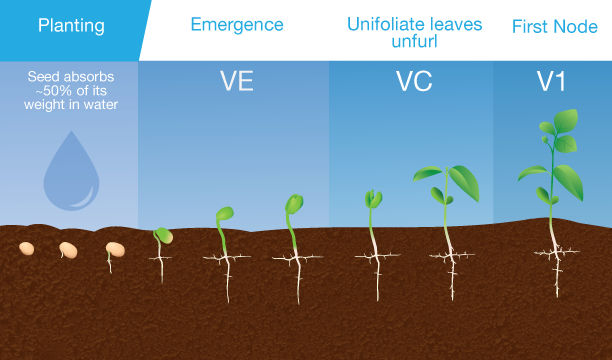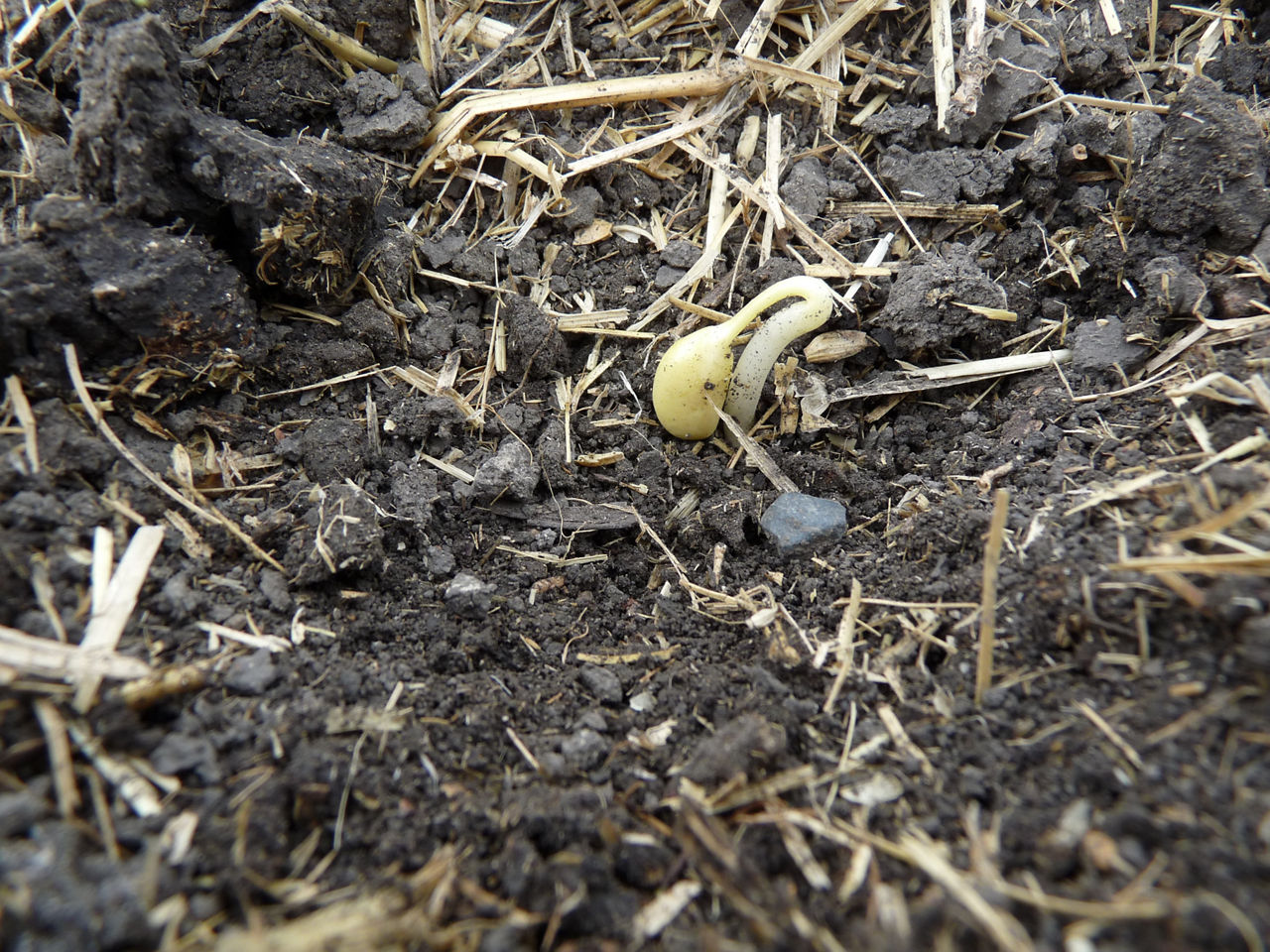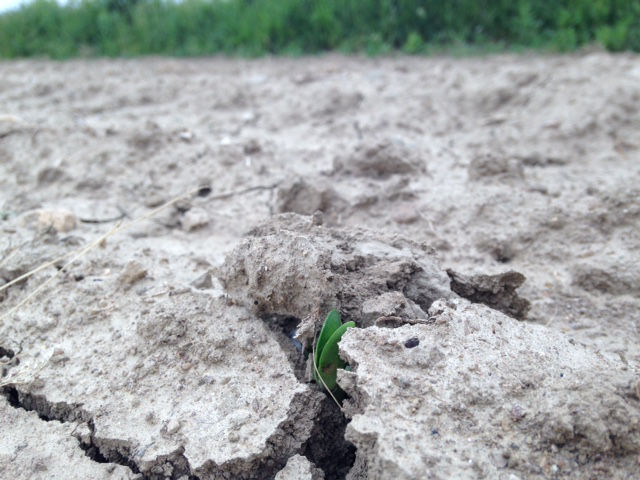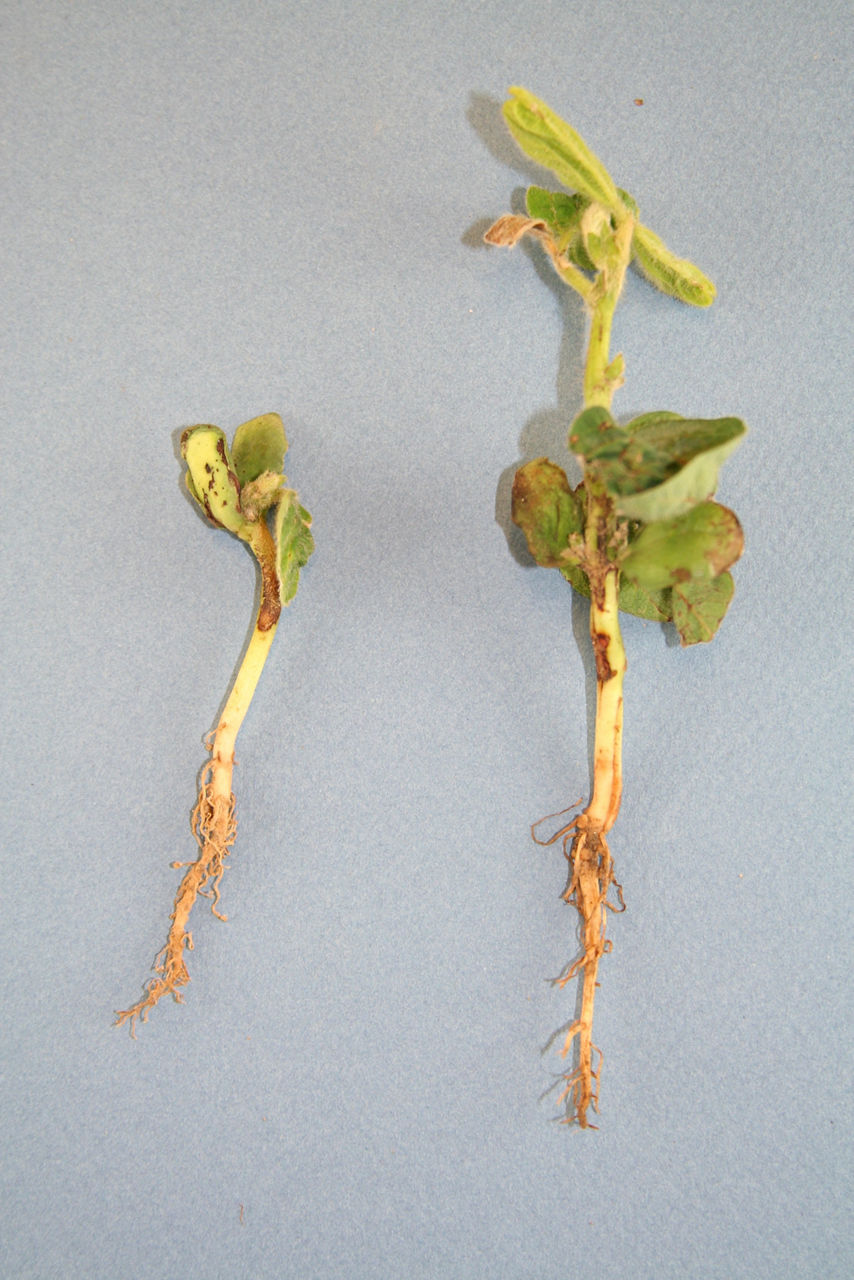3 MIN READ
Conditions That Impact Soybean Germination and Emergence
March 26, 2024
KEY POINTS
- After planting a soybean seed in an environment conducive to germination, the seed will absorb about 50% of its weight in water and the radical, or primary, root will emerge.
- Soybean germination depends on the soil temperature, moisture, and oxygen levels within the seed zone.
- The ideal soil temperature for soybean germination and emergence is 77 °F (25 °C).
- A soybean seed can slowly start to germinate in a soil temperature as low at 50 °F (10 °C) at 2 inches (5 cm) planting depth.1
- The correct soybean planting depth is 1 to 2 inches (2.5 to 5 cm), depending on the soil conditions at planting, especially soil moisture.
- The cotyledons are the first leaves to appear. They serve as food storage structures until the true leaves emerge.
- Pre-plant PPO-inhibiting herbicide applications can cause injury when there are cool, wet conditions at emergence.2
The Germination Process
Once planted, a soybean seed begins to absorb water and swell. After the seed has absorbed approximately 50% of its weight in water and if temperature and oxygen conditions are favorable, the radicle breaks through the seedcoat (Figure 1) and rapidly develops into the primary root. Lateral roots emerge from the radicle as it elongates, and root hairs grow from the radicle and lateral roots. The root hairs become the main water- and nutrient-absorbing structures. Root hairs are barely visible and should not be confused with branch roots, which are easily seen and will develop later. Soon after the radicle appears, the hypocotyl, or stem tissue, starts growing and forms a hook shape which pushes upward toward the soil surface. When the hypocotyl emerges into the light it straightens and, in the process, pulls the cotyledons out of the soil (Figure 1). Once the cotyledons reach the surface, they turn green due to exposure to light and open to expose the epicotyl, which contains the main growing point of the soybean plant.

Early Growth
The epicotyl is the stem tissue just above the cotyledons. The epicotyl contains the first leaves, which are unifoliate (one leaf blade attached to opposite sides of the stem at the same node) (Figure 1). The first leaves open quickly to start the photosynthetic process. The first trifoliate leaves subsequently emerge from the growing point above the unifoliate leaves. After about a week, the cotyledons dry and drop off the plant because their stored energy has been depleted. Energy production in the soybean plant is now solely dependent on photosynthesis by the leaves.

Challenges to Germination and Emergence
As mentioned above, soybean germination and emergence depend on the soil temperature, moisture, and oxygen levels within the seed zone. A soybean seed can germinate when soil temperatures are less than 55 °F (13 °C); however, germination is likely to be slow until soil temperatures warm to the upper 70s °F (mid 20s °C). When soil temperatures are between 70 °F (21 °C) and 90 °F (32 °C), seedling emergence should occur in less than a week. Lower soil temperatures can cause seeds to remain dormant, increasing their vulnerability to diseases and feeding damage from insects and wildlife, while soil temperatures above 95 °F (35 °C) can inhibit soybean germination and emergence, resulting in reduced stands.4 High soil temperatures often cause problems with double-cropped soybean, as the planting window will usually occur during the early summer when soil temperatures can often be above 95 °F (35 °C).
If irrigation is required to help fill the soil profile, it should be applied before planting soybean. Cold irrigation water used immediately after planting can cool the soil, slowing germination and early plant growth. Planting into a moist seedbed with good seed-to-soil contact is also necessary for the seed to absorb enough water to germinate. Though if surface moisture is low after planting, a light application of less than an inch of water can be provided by a center pivot irrigation system to help a crop germinate. Note that more than one application may be required. Heavy rainfall or heavy irrigation can result in surface crusting if the soil surface dries out before emergence. A hard soil crust can delay or prevent seedling emergence and cause soybean hypocotyls to swell or break as they try to push through the crust. If a seedling’s hypocotyl breaks or its cotyledons do not reach the soil surface, it will die. Fields with fine-textured soils, low organic matter, and little surface residue can be vulnerable to crusting, especially where excessive tillage has taken place (Figure 3). A light, center pivot irrigation application of less than an inch of moisture can also be used to soften soil crusts that may be present when seedlings emerge, softening the crust as the cotyledons break through the soil surface.

Saturated, flooded, and compacted soils can reduce germination and slow emergence due to a lack of oxygen. Soil pore spaces filled with water have less oxygen available for seed respiration.
Compaction reduces the availability of water and oxygen required for germination, growth, and nutrient uptake. However, some management strategies can be used to help reduce the previously mentioned challenges caused by planting soybean into low soil temperatures. A seed treatment like Acceleron® Seed Applied Solutions can help protect seedlings from fungal diseases like Phytophthora, Pythium, Rhizoctonia, or Fusarium, and an insecticide can help control early season pests.3 Additionally, If plant-parasitic nematodes such as soybean cyst nematode (SCN) are known to be a problem, a seed treatment like ILeVO® seed treatment can also be added to help protect the plants.
Pre-emergence Residual Herbicide Injury to Emerging Soybean
Pre-emergence, PPO-inhibiting herbicides are commonly applied as part of a pre-mix product used as additional modes-of-action to control a broad weed spectrum. The label states that these products are to be applied within three days after planting. If pre-emergence, PPO-inhibiting herbicides do cause damage to soybean plants, the signs of damage will often show up in cool, wet conditions that can slow emergence. Damage can also be observed if the growing season has been dry after planting, but the grower receives a light rainfall of 0.2 to 0.4 inches of moisture or applies a light irrigation just as the soybeans emerge through the soil surface. In this scenario, the dry post-planting conditions could have allowed the herbicide to remain on the soil surface and the following moisture could have moved the herbicide into the seed row and onto the emerging seedlings. The signs of PPO-inhibiting herbicide damage to the seedlings can vary, but often appear as a “burnt” reddish-colored spot to the side of the hypocotyl or on the already emerged leaves, which can often be confused with phytophthora root rot. 2 Always read and follow the herbicide label directions.

Sources
1Specht, J., Rees, J., Elmore, R., Mueller, N., and Glewen, K. 2019. Soybean germination/emergence with April planting dates relative to coincident air and soil temperatures in April and May. University of Nebraska – Lincoln. Institute of Agriculture and Natural Resources. Cropwatch. https://cropwatch.unl.edu/2019/soybean-germination-tracking
2Rees, J., Jhala, A., and Jakson-Ziems, T. 2020. Q & A: What is causing problems with soybean emergence? University of Nebraska – Lincoln. Institute of Agriculture and Natural Resources. Cropwatch. https://cropwatch.unl.edu/2020/q-what-causing-problems-soybean-emergence
3Acceleron® soybean protection. Bayer Crop Science. https://www.cropscience.bayer.us/seedgrowth/acceleron/soybean
4Egli, D.B., Hatfield, J.L., Hill, J., and TeKrony, D.M. 1973. The influence of soil temperature on soybean seed emergence. University of Kentucky UKnowledge. Agronomy Notes. 5-1973 https://uknowledge.uky.edu/cgi/viewcontent.cgi?article=1200&context=pss_notes
Web sites verified 02/16/2024 1316_115191